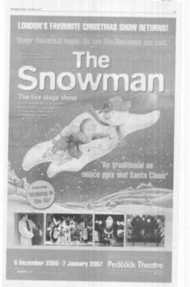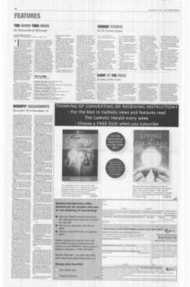Page 7, 8th December 2006
Page 7

Report an error
Noticed an error on this page?If you've noticed an error in this article please click here to report it.
Tags
Share
Related articles
Benedict Xvi Proves He Is The Master Of The Spontaneous...
Pope To Visit Mosque In Jordanian Capital
A Visit That Showed A Pope At The Height Of His Powers
Benedict Xvi Hails Reason During Visit To Mosque
The Pope Flies Into The Lion's Den
Pope prays beside mufti during mosque visit
Benedict XVI delights Turkish Muslims by pausing for 'a personal, intimate prayer' during a visit to Istanbu.'s celebrated Blue Mosque
VISIT TO THE BLUE MOSQUE
BY STAFF REPOR1EH
IN A gesture of respect to Muslims in Turkey and around the world Pope Benedict XVI prayed in Istanbul's famous Blue Mosque, his first papal visit to an Islamic place of worship.
As the Pope walked with Mustafa Cagrici, the grand mufti of Istanbul, to the mihrab niche that points the way toward Mecca, the mufti said he was going to pray.
The Pope stood alongside him, bowed his head and moved his lips in silence for about a minute.
The November 30 encounter was warm and cordial and contrasted sharply with recent controversies and tensions between the Pope and the Muslim world. The 20-minute stop was a lastminute addition to the papal programme.
The Pope accepted the gift of a ceramic tile inscribed with the word "Allah" in the form of a dove.
Placing his hand on the tile, the Pope said: "Thank you for this gift. Let us pray for brotherhood and for all humanity."
"Your Holiness, please remember us," the mufti replied.
Built by Sultan Ahmet I in the early 1600s the Blue Mosque, with six minarets and cascading domes, is one of the most famous religious buildings in the world.
The Pope entered its carpeted prayer hall after taking off his shoes and donning a pair of white slippers, listening carefully as his guides explained the architectural history of the mosque and the religious significance of its spaces.
He looked up to admire the Arabesque designs of the domes and the intricate blue tiles that give the mosque its name and its distinctive atmosphere.
Then, as they drew close to the carved marble tnihrab the grand mufti told the Pontiff: "In this space everyone stops to pray for 30 seconds, to gain serenity."
The mufti told the Pope he was going to pray. The Pope, his arms folded over his pectoral cross, stood next to the mufti and moved his lips, a moment shown in close-up on Turkish television.
When they turned away, according to a reporter on the scene, the Pope told the mufti: "Thank you for this moment of prayer."
Asked to elaborate afterward, the Vatican spokesman, Jesuit Fr Federico Lombardi, said: "The Pope paused in meditation, and certainly he turned his thoughts to God."
This could be called a moment of personal prayer, the spokesman said, but did not include any of the exterior signs of Christian prayer. In this way, he said, the Pope underlined what unites Christians and Muslims, rather than any differences.
"In this sense it was a personal, intimate prayer to God," Fr Lombardi said, which "can easily be expressed with his mind and with his thoughts also in a mosque, where many people cultivate the same spiritual attitude".
Later, the Pope presented the mufti with a framed mosaic of doves.
"This picture is a message of brotherhood in the memory of a visit that I will surely never forget," Pope Benedict said.
The Pope smiled and looked relaxed throughout the visit, which was conducted with the aid of a young Turkish interpreter. It was the second time a Pope had entered a Muslim place of worship. John Paul Il visited a mosque in Damascus, Syria, in 2001.
Moments before entering the Blue Mosque Pope Benedict visited the Haghia Sophia Museum, an architectural masterpiece once regarded as the finest church of the Christian Byzantine Empire.
The two stops in the Sultanahmet district of old Istanbul touched on Turkey's rich cultural heritage and its troubled history as a crossroads of East and West.
The Haghia Sophia, originally the Church of Holy Wisdom, was converted to a mosque in the 15th century after the conquest of Constantinople by the Islamic-dominated Ottoman Empire. It was turned into a museum in the 1930s after Turkey became a secular state.
A week before the Pope arrived, police detained 39 Muslim fundamentalists who entered the Haghia Sophia and shouted slogans against the papal visit. Some Muslims feared the pope wanted to reclaim the. monument as a church by praying there.
Protesters were kept far away from the site during the Pope's visit, although three demonstrators were dragged from the Haghia Sophia a few
hours before the Pontiff arrived. Heavily armed police officers ringed the area around the museum and shut down all traffic in the neighbourhood.
When he made his 25minute stop in the Hagia Sophia the Pope was following in the footsteps of his predecessor, Pope John Paul, who visited the site in 1979.
Escorted by the museum president the Pope walked beneath the massive dome of the sixth-century building, pausing to look up at Byzantine mosaics of Christ, Mary and Byzantine emperors and, next to them, the characteristic wooden ceiling medallions with the calligraphic names of Allah and Mohammed.
When his guide explained that the dome was 184 feet tall and 102 feet wide, the Pope asked if it was bigger than that of St Peter's Basilica. St Peter's was bigger, he was told.
The Pope asked a few questions but mostly listened during his tour. He was surrounded by a phalanx of Vatican aides and security personnel.
Before leaving he stopped to write in the museum's guest book.
"In our diversity, we find ourselves before faith in the one God. May God enlighten us and help us find the path of love and peace," he wrote.
CHHEDRAL MASS INISTANBUL
BY :TAFF REPORTER
ENIING his four-day pilgimage of dialogue in Tuxey Pope Benedict XVI celibrated Mass with the tire Christian conummity in Isteibul and encouraged it to live in harmony with the Mislim majority.
'Brothers and sisters, your conmunities walk the hunble path of daily conpanionship with those wht do not share our faith, yetprofess to hold the faith of Abraham, and together win us adore the. one, meriful God," the Pope sale in a sermon.
'You know well that the Chirch wishes to impose noising on anyone, and that shemerely asks to live in freedom, in order to reveal theone whom she cannot hide Christ Jesus," he said.
About 300 people packed intr the Cathedral of the HoY Spirit for the December] Mass. Several hundred more stood in the cathedral's inner plaza and in the courtyarl of a nearby church, folbwing the liturgy on a television screen.
Turkey has only 32,000 Canolics in a population of 72 million. Most of them live in Istanbul, which has for .7.enturies been a bridge to tie West.
The Pope, wearing red vestments to mark the work of the Holy Spirit, processed intothe small church and listened as Armenian Canolics chanted the entrance song. A Chaldean char of youths, dressed in blue tunics, sang a hymn in Aramaic.
The seven languages used in tie liturgy were meant to exp-ess the diversity of the Catholic community in Turcey.
The Pope paid tribute to thisrich variety, asking Turdsh Catholics to continue to live the faith in a humble manner with a sense of service to others,
"lo live by the Spirit is not to live for oneself alone, but to let oneself be coniermed to Christ Jesus by becoming, like him, the sersant of his brothers and sisters," he said.
As a minority in a Muslim country, he said, Catholics should be attentive to all time who seek justice, peace and dignity.
"Live in harmony, in accordance with the words
of the leird: `By this everyone will know that you are my disciples, if you have love for one another.— he said.
To one side of the altar sat Orthodox Ecumenical Patriarch Bartholomew of Constantinople, who had hosted the Pope the day before in a liturgy at his Istanbul headquarters, the ecumenical focus of the Pope's visit.
The Pope recalled that his predecessor, Pope John Paul H, in a Mass 26 years earlier in the same cathedral, had urged new efforts for full Christian unity. Unfortunately, Pope Benedict said, that hope has not yet been realised, but "the Pope still longs to see it fulfilled".
He urged all Christian leaders to act for the good of all, "putting ecumenism at the forefront of our ecclesial concerns and not committing our respective churches and communities to decisions that could contradict or harm it".
Those words appeared to refer to potential problems not so much with Orthodox churches as with the Anglican Communion. Several Anglican member churches have decided to ordain women priests and some to ordain women bishops, decisions the Vatican says create a serious barrier to full union with the Catholic Church.
Patriarch Bartholomew joined the Pope for the final blessing. Then,the Pope processed down the main aisle, smiling broadly and greeting many of the enthusiastic faithful who reached out from either side. One man waved a Turkish flag.
Before the Mass, the Pope blessed the statues of two popes in the courtyard of the cathedral: Pope John XXIII, who served for 10 years as apostolic nuncio in Turkey and was considered a good friend of the country; and Pope Benedict XV, who during World War I built hospitals in the region and made diplomatic moves in favour of Turkish prisoners.
The larger-than-life bronze statue of Pope Benedict XV was unveiled in 1921 at a ceremony attended by many Muslim Turks. It bears an inscription hailing the pontiff as "the benefactor of all peoples, regardless of nationality or religion".
After blessing the statues, the Pope released four doves, one at a time, as a symbol of peace.
blog comments powered by Disqus



















